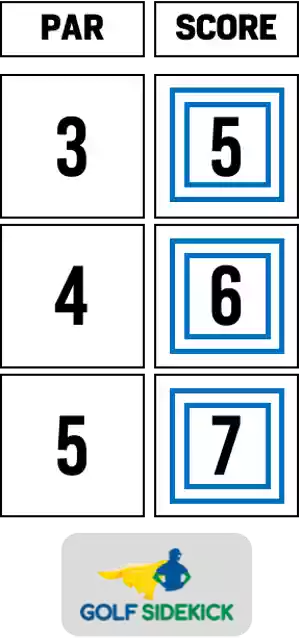Last Updated on December 26, 2023 by Matt Greene
What is par?
Par is the standard that golfers try to achieve. It is important to note that par is a score which an expert golfer or professional golfer would be expected to make on that individual hole. Most golfers expected score on a hole could be anywhere from 1 to 3 shots over par depending on their golfing ability and experience.
How does par work?
Every hole on a course is given its own par rating which is defined loosely by the length of an individual hole. Typically, longer holes require more shots to complete, therefore the par for these holes is greater in comparison to holes with fewer yards.
Is par a good score?
If you're making pars on the golf course, you are playing to a high standard. Professional golfers will make mostly pars when playing a complete round. Recreational golfers making pars regularly should be proud. A scratch golfer would be considered to be playing to a par score regularly.
How many strokes to score a par?
Most golf courses will consist of par 3, par 4 and par 5 holes. On a par four for example, an expert golfer is expected to score four shorts: hit two shots to reach the green, then take two putts to get the ball into the hole.
A scorecard would read like this for 3 pars in a row:

What is par for 18 holes in golf?
Par over 18 holes is usually 72 strokes. Some course may be as much as par 74 or 73. There are executive courses which could be a lower par, from par 54 to par 69. Most professional level golf courses will have pars between 70 and 73.
What is par for 9 holes?
Half a round is usually the 18 hole par divided by any random 9 holes could have a par anywhere between 27 and 38.
What does par 72 mean?
Par 72 means that the 18 holes on that golf course should be playable by a scratch handicap in 72 strokes.
Scoring relationship and par
If you have ever watched golf on the television, you will have heard the golf terms "level par", "even par", "under par" and "over par."
These are used to describe a player's scoring relationship relative to par. For example if a player plays the first hole of a golf course, (a par 4) in for shots, they would be level par or even par through one hole. If they then made a hole in one on the next par 3, (unlikely) they would be 2 under par.
Here's a link to more golfing terms.
What does under par mean in golf?
Under par means the golfer scores a number of strokes into the hole, less than the number stipulated on the scorecard. The names for these scores are birdie, eagle and albatross.
On a par 4, that would be 3 or fewer strokes.
On a par 5, that would be 4 or fewer strokes.
On a par 3, that would be 2 or fewer strokes.
Over 9 holes, you can add up a score and be considered 'under par' if your total score is below the total number for par on that nine.
Over 18 holes, you add up your score and be considered 'under par' if your total score is below the total number for par on that course.
What is an eagle in golf?
Scoring an "eagle" means to get the ball in the hole in 2 strokes under par for that golf hole. It is a score which is usually made by expert or professional golfers.
How many shots do you need to score an eagle?
We know that an eagle corresponds to getting the ball into the hole in 2 under the par of that hole. Therefore to score an eagle, you would need to have the ball in the hole in:
One stroke on a par-3 hole
This is normally called a hole in one and is extremely rare! Pretty much a miracle golf shot.
Two strokes on a par-4 hole is an eagle.
Usually a result of a holed approach shot or chip in. In golf terms this is still pretty rare but can happen on shorter holes.
Three strokes on a par-5 hole is an eagle.
Most eagles are made this way. Hit the ball off the tee, second shot hits the putting green, hole the putt.
What shape is used for an Eagle on a scorecard?
Two concentric circles are used to represent an eagle on a scorecard or a PGA Tour overlay.

Where does the term eagle come from?
The basis of the term eagle is linked with the other ornithological golfing term “birdie.” An eagle is a big rare bird or "big birdie" and is thus considered to be less common and better version of a "birdie." It's one of many golfing terms which we need to learn.

What’s better than an eagle in golf?
A double-eagle or albatross is better than an eagle. So albatross or double-eagle is 3-under par. And it’s supposed to be an even more infrequent or rarer occurrence in the game of golf, hence even more celebratory.
What is a double-eagle?
A double eagle (also known as an albatross) is a score of 3-under par on the hole, which, only when possible, is done on a par-4 hole and a par-5 hole.
A par-4 double eagle would require a hole-in-one. Double eagle can be made on a par-5 if you hold your second shot.
What is a birdie in golf?
A player makes a birdie when he uses one fewer strokes than the par of the hole.
Let's break this down using an example from the golf course. We are on a par 4 hole. The aim here is to get the ball into the cup in 4 shots, to make par. If you manage to get the ball into the hole in 3 shots, this would be 1 under par for that hole and called a birdie. If you were on a par 5 hole and took 4 strokes to hole out, this would also be a birdie.
What is double bogey in golf?
A Double Bogey is a golfing term that refers to a player scoring two strokes more than the par of the particular hole that they are playing. It's one of the more common golf scoring terms and will be all too familiar to most recreational golfers!
Ideally, we want to avoid double bogey at all costs, but for most golfers it's an inevitable part of a round of golf.
Here's a quick guide to make it super clear what scores make up a double bogey on holes with a different par rating:
- A score of 5 is a double bogey in a par 3 hole
- A score of 6 is a double bogey in a par 4 hole
- A score of 7 is a double bogey in a par 5 hole
What shape is used for a double bogey?
On scorecards and on the overlays in the PGA Tour broadcasts, you'll see shapes around the numbers on the scoreboard. When you score a double bogey, you can draw a double square around the number to represent and make it easier to count the score up at the end.

Is a double bogey good?
If you're a total beginner golfer, double bogey is actually a good score on the golf course. As you get better, you will try to eliminate double bogey as a score. For professional golfers, scores of bogey or double bogey are pretty disastrous for their score.
What's worse than a double bogey?
A triple bogey or quadruple bogey is worse than a double bogey. While double bogey is two over regulation par for a scratch golfer, a triple bogey is 3 over par while a quadruple bogey is 4 over. No one wants these!
Does everyone make double bogeys?
The simple answer is, yes! Even the best golfers will make double bogeys and worse throughout their golfing life so don't be too hard on yourself when you inevitably make one. the best thing you can do is put a bad score behind you and move onto the next hole. Who knows, your next shot could be your best shot.
Double bogey golf handicap
If you make double bogey on every hole, your handicap will be around 30. Your score will be 108 shots or 36 over par on a par 72 course.
